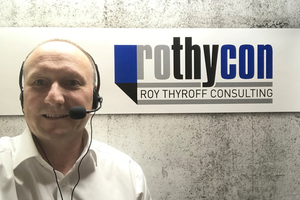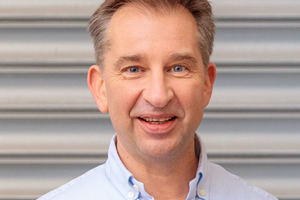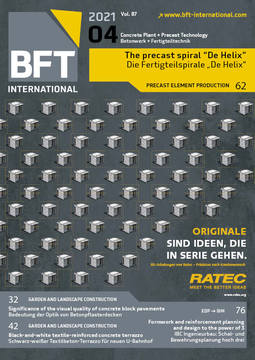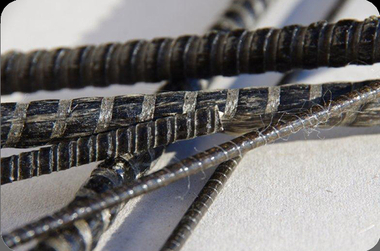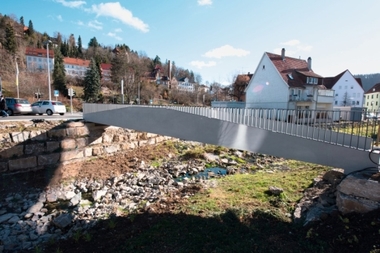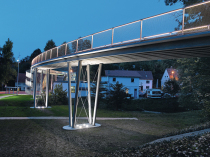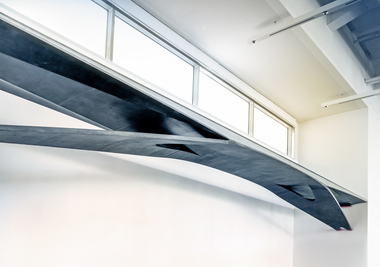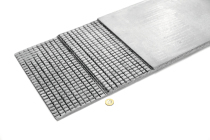Textile-reinforced concrete: Still more of a niche application
Germany is considered the cradle of carbon concrete: research and development work has been going on for 25 years; for the past twelve years, the new type of lightweight construction material has often been a talking point only in terms of special approvals and, for the major part, reference projects. Four questions each from author Hans-Werner Oertel, on behalf of BFT International, to Roy Thyroff, Managing Director of Composites United Bau, and Manuel Vöge, Managing Director of BNB.
BFT International: Why is mass use still a long time coming?
R. Thyroff: We are still in a niche at the moment but I do have a feeling that the market is now ready for this technology. However, the order books in the industry are currently full, which has in turn reduced the willingness to invest in this segment of lightweight construction, both in terms of time and money. Needless to say that the German building law and its approval and standardization requirements also prevent a more dynamic use. If carbon concrete is to be on a par with reinforced concrete one day, a great deal of guideline and standardization work will be required in the future.
BFT International: What is to be done on the part of the public authorities?
R. Thyroff: Against the backdrop of the CO2 pollution caused by cement production and the shortage of sand, it is ultimately up to politicians to force the construction industry to make better use of resources by establishing guidelines and frameworks. This would also pave the way for the mass use of carbon concrete even in such broad fields of application as building renovation, façade construction and the renovation of industrial floors, which in turn would require standards and technical approvals.
BFT International: What is the situation in other parts of the world?
R. Thyroff: A lot is happening in this sector in Asia and the US. To my knowledge, the largest number of carbon patents per capita has been filed in South Korea in recent years. There is a huge market for carbon reinforcements (scrims, fibers, bars) in the US, as well as in Asia and the United Arab Emirates. The quantities now processed in these countries are unthinkable in security-driven Germany.
BFT International: Who are the drivers for this technology in Germany?
R. Thyroff: The industry association for multilateral lightweight construction, Composites United e. V., as partner of the Ulm BetonTage conference, as well as the 160 partners from science and building practice participating in the C3 (Carbon Concrete Composite) cluster. Our agenda at the CU Bau network includes not only the technology as such but also issues of practical relevance such as sustainability and recyclability. The textile industry is now also able to provide large quantities of textile grids. Textile-reinforced concretes with non-corrosive reinforcements are available and scalable, especially since three German companies based in Hof, Albstadt and Augsburg have now established themselves as producers.
BFT International: BNB has been leaving its marks for many years also with elements made of textile-reinforced concrete?
M. Vöge: And not just in the Berlin region. In general, textile-reinforced concrete can be used to realize extremely small element cross sections and curved geometries – which is of advantage both for façade design and for outdoor furniture or interior fittings, such as those in the KaDeWe department store. Elements made of textile-reinforced or carbon concrete are simply eye-catchers, enhancing the architectural expression. That is why an increasing number of architectural firms are drawing upon our expertise gained in collaboration with scientific institutions.
BFT International: What were the particular challenges posed by the subway contract?
M. Vöge: No doubt the topics environmental protection and global warming will come back in the focus. On this field, Chinese manufacturers are still seen critically. However, I need to point out that our partner Hyrox has completely renovated and modernized its production site in Deqing. Now it runs state-of-the-art technologies for the treatment of wastewaters and exhaust air. The whole project took three years and was successfully completed in 2018. I have had the chance to personally see for myself during various visits.
BFT International: Why the need for so many special formats?
M. Vöge: The architect gave us three special assignments that we had previously never implemented in this way: one criterion of the station’s highly dynamic exterior design are curved façade elements, for example, which are used to round off the edges towards the escalator shafts. Another difficulty was posed by the slight gradient of the station and the resulting challenge to produce a perfect horizontal joint pattern. We have solved this problem by means of high-precision measurement, transfer into CNC data and, finally, CNC buffing. The third challenge: all panels of the curtained façade needed to be fully removable in view of the safety inspections of the formwork concrete to be performed by the TÜV.
BFT International: You have completed the contract in four years; is there anything that could be optimized?
M. Vöge: Considering the four years spent “underground”, a lot could be optimized in terms of the effort involved – such as site logistics. We would use a CNC milling machine on site. Façades in lightweight design are a focus of research and development for us even beyond transport construction.
BFT International: Mr. Thyroff, Mr. Vöge, thanks for the conversation and for the future the very best!
Interview: Hans-Werner Oertel for BFT International

